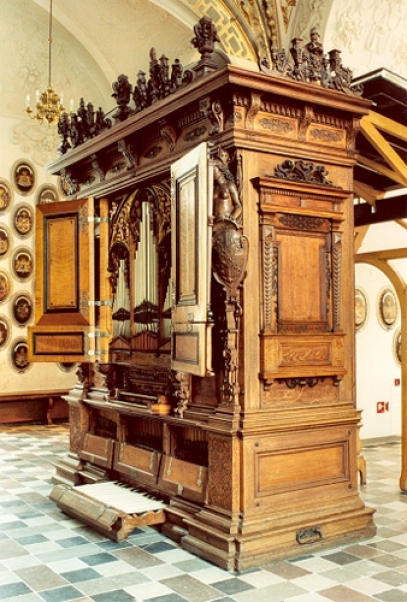


Frederiksborg, Slotskirke

Esaias Compenius 1610 (Praetorius erroneously gives 1612)
State of preservation: all relevant parts original
Presumably the organ was designed and made in a cooperation of Compenius and the court chapel director Michael Praetorius.
Originally built for duke Heinrich Julius of Brunswick for his castle Hessen near Wolfenbüttel it was presented to king Christian IV of Denmark in 1616/17 and transfered to Frederiksborg north of Copenhagen. A first description was published by Michael Praetorius in his Syntagma Musicum II: De Organographia (Wolfenbüttel 1619, p. 189). By a happy coincidence it was not damaged when the castle caught fire in 1859.
All pipes are made of wood, the front diapason 4' of ivory, front-plated with ebony. This rare peculiarity gave this organ an aura of excellence from the start which kept it from later modernisations.
The number of 9 stops in every division represents an ideal of harmony and balance typical for the Northern Renaissance. This concept offered the technical and musical options eg for playing chorales with a slow treble melody line taken by the pedal. Therefore the pedal offers a variety of suitable stops from 4' to 1' as well as a 16' in the manual to give a bass fundament.
Music sample
Jan Pieterszoon Sweelinck (1562-1621): Variations on “Mein junges Leben hat ein End“
played by Francis Chapelet
Specification
Manual C-c3 , Pedal C-d1
Oberklavier (HW):
Groß Principal 8’
Groß Gedackt Flöt 8’
Principal 4’
Gems Horn 4’
Nacht Horn 4’
Plock Flöt 4’
Gedackt Quint 3’
Klein Flöt 2’
Rankett 16’
Unterklavier:
Quinta Dehna 8’
Gedackt Flöt 4’
Principal Cantus [D] 4’
Block Flöt Cantus [D] 4’
Gems Horn 2’
Nasart 1½’
Zimbel ¼’ 1f. [repeating]
Krum Horn 8’
Klein Regal 4’ [Geigendregal]
P:
Gedackt Flöten Baß 16’
Gems Horn Baß 8’
Quinta Dehn Baß 8’
Quer Flöt Baß 4’
Nacht Horn Baß 2’
Pauer Flöt Baß 1’
Sordun Baß 16’
Dulcian Baß 8’
Regal Baß 4’ [Jungfernregal]
Effects:
Manual coupler, Tremulant Pedal, "Großer Bock" (Tremulant organ), Sackpfeiffe (flue drone on C), Kleinhümlichen (reed drones on F and c0)
Stop names are given at the organ with initials of the above mentioned stops for example „GP“ for Großprincipal, „GH“ for Gemshorn or „QDB“ for Quintadenbaß (except the doubled letters „PP“ for Principal and „RR“ for Rankett); for this reason the spellings here differ slightly from those given by Praetorius.
© Greifenberger Institut für Musikinstrumentenkunde | info@greifenberger-institut.de



